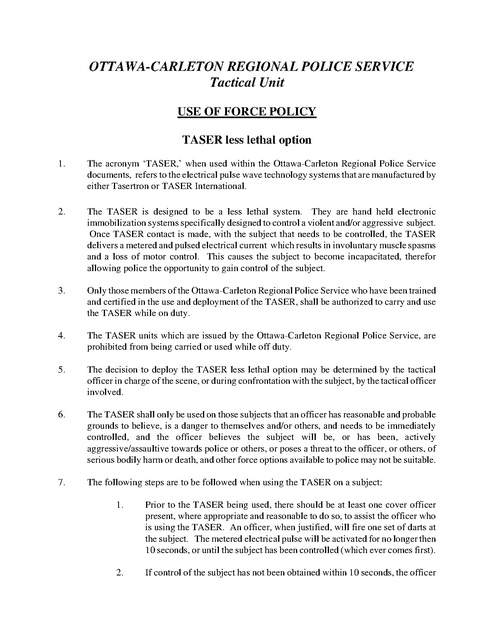Taser Ottawa-carleton Regional Police Use of Force Policy
Download original document:

Document text

Document text
This text is machine-read, and may contain errors. Check the original document to verify accuracy.
OTTAWA-CARLETON REGIONAL POLICE SERVICE Tactical Unit USE OF FORCE POLICY TASER less lethal option 1. The acronym ‘TASER,’ when used within the Ottawa-Carleton Regional Police Service documents, refers to the electrical pulse wave technology systems that are manufactured by either Tasertron or TASER International. 2. The TASER is designed to be a less lethal system. They are hand held electronic immobilization systems specifically designed to control a violent and/or aggressive subject. Once TASER contact is made, with the subject that needs to be controlled, the TASER delivers a metered and pulsed electrical current which results in involuntary muscle spasms and a loss of motor control. This causes the subject to become incapacitated, therefor allowing police the opportunity to gain control of the subject. 3. Only those members of the Ottawa-Carleton Regional Police Service who have been trained and certified in the use and deployment of the TASER, shall be authorized to carry and use the TASER while on duty. 4. The TASER units which are issued by the Ottawa-Carleton Regional Police Service, are prohibited from being carried or used while off duty. 5. The decision to deploy the TASER less lethal option may be determined by the tactical officer in charge of the scene, or during confrontation with the subject, by the tactical officer involved. 6. The TASER shall only be used on those subjects that an officer has reasonable and probable grounds to believe, is a danger to themselves and/or others, and needs to be immediately controlled, and the officer believes the subject will be, or has been, actively aggressive/assaultive towards police or others, or poses a threat to the officer, or others, of serious bodily harm or death, and other force options available to police may not be suitable. 7. The following steps are to be followed when using the TASER on a subject: 1. Prior to the TASER being used, there should be at least one cover officer present, where appropriate and reasonable to do so, to assist the officer who is using the TASER. An officer, when justified, will fire one set of darts at the subject. The metered electrical pulse will be activated for no longer then 10 seconds, or until the subject has been controlled (which ever comes first). 2. If control of the subject has not been obtained within 10 seconds, the officer should consider that the first set of darts have either missed or failed to work. 8. 9. 3. If the subject has failed to be controlled with the first set of darts, than the officer may discharge a second set of darts at the subject, if appropriate and reasonable to do so. The metered electrical pulse will be activated for no longer then 10 seconds, or until the subject has been controlled (which ever comes first). 4. If control of a subject has not been obtained within 10 seconds after the application of the second set of darts, consider the TASER to be ineffective in controlling the subject and move to an alternate/appropriate force option to gain control. Once the subject has been controlled through the use of the TASER, officer(s) should make every effort to do the following when appropriate and reasonable to do so: 1. Immediately handcuff the subject behind their back 2. Advise the subject that they have been tasered and that the effects are only short term 3. Monitor the subject and contact ambulance service to attend the scene/location. Advise the ambulance attendants that the subject was tasered, and that the subject be transported to a hospital to be examined by a emergency room physician. 4. Police officers shall not remove darts that have punctured the skin of the subject and have remained imbedded. This shall be done by a qualified medical staff. If the darts have only penetrated clothing and are not imbedded in the subject, the officer is now authorized to remove the darts prior to transporting the subject to the hospital. The ‘TASER Statistic Report’ form must be completed in detail after being deployed where it was used as a use of force presence, or discharged to cause a motor dysfunction. The original will be forwarded with the occurrence report and a copy will stay will the Tactical Units occurrence report.




